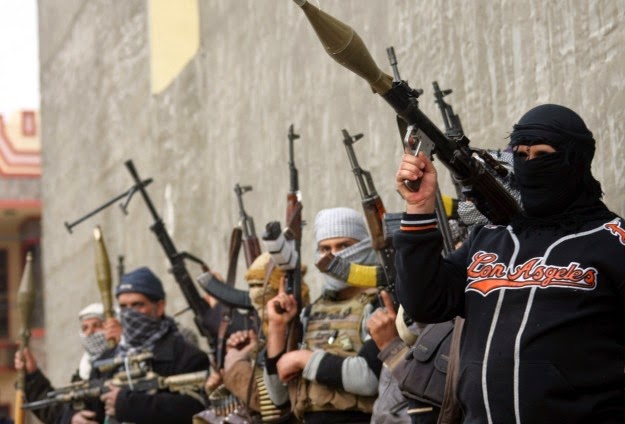Militant groups claiming to represent ISIL are reportedly trying to replace the Taliban but many in Afghanistan question whether there is any difference
For almost two decades, the white flag of the Taliban has been the dominant symbol of militants operating in Afghanistan, but the group is now reportedly facing competition.
Black flags used by the Islamic State of Iraq and the Levant militant group, known as ISIL, have reportedly emerged in parts of the country, according to Afghan officials and local residents.
Whether this is merely a symbolic change by militant commanders to capitalize on ISIL’s popularity among fighters, after declaring a so-called Caliphate in parts of Syria and Iraq, remains a matter of dispute in Afghanistan.
In an op-ed critical of U.S. regional policy Abdul Karim Khuram, the adviser to former president Hamid Karzai, wrote on Afghan website nunn.asia that the purported presence of ISIL “represents the beginning of a new phase of war.”
“New slogans, new forces and new operating areas requires a new group of fighters to advance the war. It is difficult to fight under the name ‘Taliban’ in Central Asian states,” Khurram wrote, hinting that there would be a wider fight, beyond Afghanistan.
The apparent emergence of a group with new allegiances is confirmed by local residents. Haji Abdul Latif, an elder of the southern Helmand province, told Anadolu Agency that the fighters swearing loyalty to ISIL had been battling with Taliban militants in the province.
Latif said they were under the leadership of Mullah Abdul Raouf, a former Taliban commander who spent at least six years imprisoned in Guantanamo Bay after being captured by U.S. troops in 2001, who has now telling his fighters to operate under the ISIL flag.
Saeeduddin Sanginwal, an elder of the restive Sangin district, said the newly ISIL-inspired Afghan group sparked the anger of the Afghan Taliban when it raised its black flags in the district, where departed foreign troops had recently handed over security responsibilities to Afghan national security forces.
According to Sanginwal, the replacement of white Afghan Taliban flags with the ISIL symbol has led to clashes between the two groups that have killed and injured up to 20 fighters.
Security officials, including the commander of Afghan ground forces, General Murad Ali Murad, also claim ISIL-inspired groups are present in parts of Afghanistan.
Murad said their “operatives are trying to make foot space in restive parts of Afghanistan, as they have already stationed in volatile southern Helmand province. They are trying to infiltrate to northern provinces of country which borders with central Asian states.”
Similarly, the police chief in eastern Zabul district, General Roogh Liwanai, said groups are trying recruit from among Afghan fighters and had begun militant activities in some parts of the province. He also claimed that hundreds of foreign militants had crossed the border from Pakistan.
Can ISIL make Afghan inroads?
General John Campbell, a top U.S. commander in Afghanistan, also confirmed recruitment activities in both Afghanistan and Pakistan in an interview with the Army Times recently but he also claimed the group have a “hard message to sell.”
Officially, Afghanistan’s interior ministry denies any ISIL presence but it has simultaneously assured that Afghan forces are capable of overcoming any militant group.
Afghan parliament also rejected last week the idea that ISIL had started substantial operations but recognized that some individual Taliban groups were now paying homage to the Iraq- and Syria-based militants.
“No difference between them, all are the same—the same people and the same program,” said the governor of Zabul province Amir Mohammad, adding that militants in Afghanistan once fought under the flag of al-Qaeda, then the Taliban.
He said they have failed to recruit from local people, who with police help have pushed the apparent ISIL-enthusiasts from their areas.
Head of the Afghanistan Women’s Council Fatana Gilani said the name used by militants does not matter, they are all part of a conspiracy to destroy the past decade of achievements for women’s rights.
“No difference between the Taliban and ISIS (ISIL). Both are bloodthirsty and not ready to respect women rights—even women in Iraq and Syria under the ISIS control are not treated as human,” she said.
Much of the reported ISIL presence has been near the borders with central Asian states — 40 Uzbek militants arrived in northern Faryab province recently, according to local residents — leading some to claim the presence is a creation of western powers, whose forces have recently withdrawn from Afghanistan.
Political expert and ex-Afghan diplomat Ahmad Saaedi is one of those who claims that the apparent ISIL presence is actually a creation of western powers who hope to benefit from instability among their rivals in the region.
Abdul Wali Neyazi, now a lawmaker but a former commander of the Mujahideen — who fought against the Soviet invasion of Afghanistan in the 1980s — also claims that the Taliban, and now ISIL, were western creations.
“Creation of the Taliban was a momentous aim of the western powers to overthrow the Mujahideen government and take a grip on central Asian countries and easily confront some nuclear nations like Iran and China,” he said, claiming that ISIL-branded fighters were simply replacing previous Afghan militants who could not infiltrate into those nations.
Several video tapes showing Taliban fighters shifting their allegiance from Taliban leader Mullah Omar to the distant ISIL leader Abu Bakr al-Baghdadi have emerged but have not been independently verified. Still, the prospect of a new militant group in Afghanistan worries many Afghans, tired after three decades of conflict in their country.
“Their extremism is the harshest and intolerable. We are tired of war, the war is enough. ISIL in Afghanistan means another 30 years of war in our country,” worries 72-year old Abdullah, an Afghan citizen.
He says he does not want to see ISIL come through his country, just as the Soviet army, and more recently American and British forces, passed through.
Source: aa.com.tr



